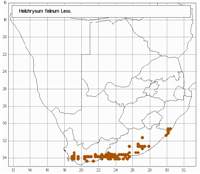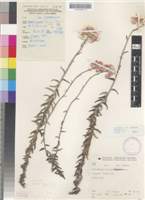Origin of name:
The epithet 'felinum' derives from Hermann (Cat. Pl. Afr. 13, 1737) who wrote 'floribus umbellatis, facie Pedis Cati'. He must have had a cat with white paws.
Diagnostic characters:
Bi-coloured lanceolate leavesLarge headsCompact inflorescencePink / white bracts
Description:
Stout perennial herb up to c. 1 m tall, stem woody, up to 5 mm diam., simple below, subsimple or branched above, branches erect, rod-like, rough with leaf scars below, loosely greyish-white woolly and densely leafy above. Leaves spreading or deflexed, up to 35 (�50) x 8 (�12) mm, sometimes smaller and distant upwards, lanceolate to elliptic, apex more or less acute, mucronate, bases broad, clasping, upper surface cobwebby at first, later harshly pubescent, sometimes glabrescent, generally rugose, lower grey woolly-felted. Heads homogamous, subglobose, 5�7 mm long, 7�10 mm across the fully radiating bracts, many in dense, rounded corymbose clusters c. 20�40 mm across, sometimes more open or becoming so with age. Involucral bracts in c. 8�12 series, subequal, loosely imbricate, about equaling the flowers, milk-white, or tinged rose-pink, often crisped, radiating. Receptacle shallowly honeycombed or shortly toothed. Flowers 38�103, yellow. Achenes not seen, ovaries with duplex hairs. Pappus bristles many, about equaling corolla, tips barbellate, bases cohering strongly by patent cilia.
Flowering between September and December.
Distribution:
Found on rough scrubby slopes. Ranges from the Western Cape, including the Peninsula, through the SE. and E. districts and the Transkei to southern KwaZulu-Natal.
Fynbos, Savanna and Thicket Biomes.
Notes:
Very variable, particularly in leaf size and colour of the involucral bracts, but easily recognized.
Taxonomy:
Literature:
Helichrysum felinum Less., Syn. Comp. 287 (1832); DC., Prodr. 6: 176 (1838) incl. vars; Harv. in F.C. 3: 225 (1865); Moeser in Bot. Jb. 44: 309 (1910); Hilliard & Burtt in Notes R. bot. Gdn Edinb. 32: 348 (1973); Hilliard, Compositae in Natal 232 (1977).
Type:
Cape, Thunberg (sheet 19159, UPS, holo.).
Synonym(s):
Gnaphalium frutescens, tomentosum, folio oblongo, floribus comosis Burm., Pl. Afr. Rar. 224, t. 79 fig. 4 (1739) (specimen in herbarium Burm. G).
G. elongatum Lam., Encycl. 2: 741 (1788); Ker-Gawl. in Bot. Reg. 3, t. 243 (1813); Curtis's Bot. Mag. t. 2328 (1822), non Helichrysum elongatum Moench (1794). Type: Cape of Good Hope (P-LAM).
G. felinum Thunb., Prodr. 140 (1800), Fl. Cap. 648 (1823), (nom. illegit.) quoad spec, excl. syn. (Thunberg, sheet 19159, UPS).
G. fastigiatum Schrank in Denkschr. K. Akad. Wiss. M�nch. 8: 148 (1824). Type: Cape of Good Hope, Brehm (M, holo.).
G. serratum sensu Thunb., Prodr. 149 (1800), Fl. Cap. 659 (1823), non L.
Vouchers:
Codd 3583 (NU; PRE); Hilliard & Burtt 10935 (E; K; MO; NU; PRE; S); Nordenstam 1914 (LD; NU); Pillans 6752 (BOL); Tyson 944 (SAM).

